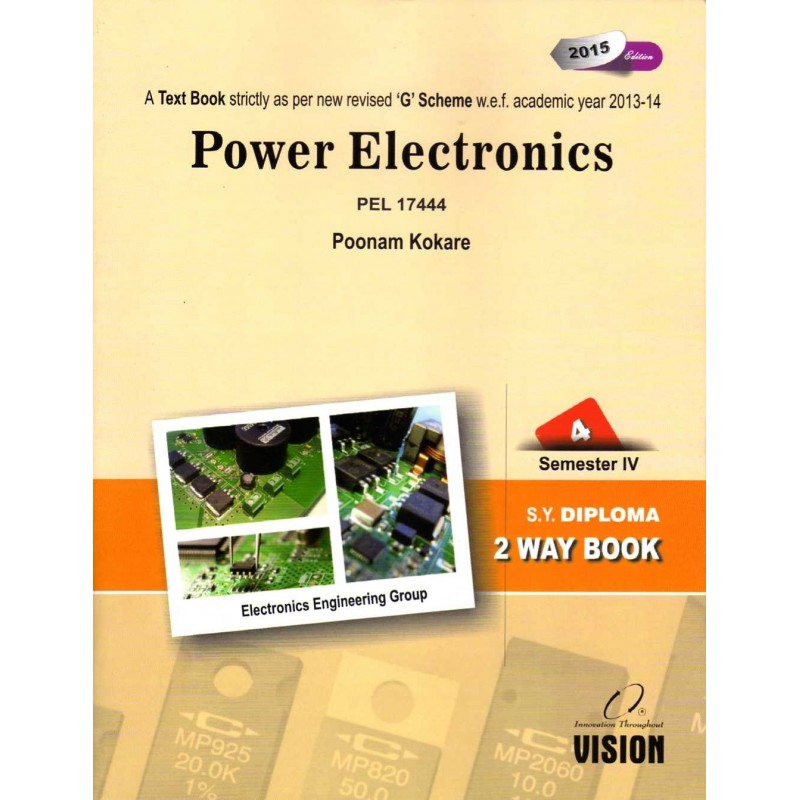Email: tovisionpune@gmail.com



A Text Book Strictly as per new revised 'G' Scheme w.e.f.
Electronics Engineering Group
Author: Poonam Kokare
Solved Question Papers upto Summer 2015
Contents
1. Power Electronics
1. Introduction
1.1 Applications of Power Electronics
1.2 Merits and Demerits of Power Electronics
2. Power Transistor
2.1 Operating Principles
2.2 Construction
2.3 Operation
2.4 Switching Characteristics of Transistor
2.5 Uses of Power Transistor
2.6 Merits and Demerits of Power Transistor
3. Power MOSFET’s
3.1 Operating Principles
3.2 Depletion-type MOSFET
3.3 Enhancement-type MOSFET
3.4 Output Characteristics
3.5 Switching Characteristics of MOSFET
3.6 Uses of MOSFET
3.7 Merits and Demerits of MOSFET
3.8 Comparison of MOSFET with BJT
4. Insulated Gate Bipolar Transistor (IGBT)
4.1 Operating Principles
4.2 Construction
4.3 Operation
4.4 V-I Characteristics of IGBT
4.5 Switching Characteristics of IGBT
4.6 Uses of IGBT
4.7 Merits and Demerits of IGBT
4.8 Comparison of Power MOSFET and IGBT
2. Thyristor Family Devices
1. Introduction
2. Silicon Controlled Rectifier (SCR) or Thyristor
2.1 Construction and Symbol
2.2 Principle of Operation
2.3 Definitions
2.4 V-I Characteristic of Thyristor
2.5 Operating Principle with Two Transistor Analogy
2.6 Merits and Demerits of SCR
2.7 Applications
3. Thyristor Family Devices
3.1 Light Activated Silicon Controlled Rectifier (LASCR)
3.2 Silicon Controlled Switch (SCS)
3.3 Gate Turn Off (GTO) Thyristor
3.4 TRIAC
4. Triggering Devices
4.1 Unijunction Transistor (UJT)
4.2 Programmable Unijunction Transistor (PUT)
4.3 Silicon Unilateral Switch (SUS)
4.4 Silicon Bilateral Switch (SBS)
4.5 DIAC
3. Turn ON and Turn OFF Methods of SCR
1. Introduction
2. Turn ON Mechanism of SCR
2.1 SCR Turn ON Method
3. Gate Triggering Circuits
3.1 Resistance Triggering Circuit
3.2 Resistance Capacitance Triggering Circuit
4. SCR Triggering
4.1 SCR Triggering using UJT
4.2 PUT – Relaxation Oscillator Circuit
4.3 Synchronized UJT Triggering Circuit
5. Pulse Transformer used in Triggering Circuit
6. Turn OFF Mechanism of SCR
6.1 Class A – Series Resonant Commutation Circuit
6.2 Class B – Shunt Resonant Commutation Circuit
6.3 Class C – Complimentary Symmetry Commutation Circuit
4. Phase Controlled Rectifiers
1. Introduction
2. Concept of Phase Control
3. Single Phase Half Wave Controlled Rectifier
4. Single Phase Centre Tapped Full Wave Controlled Rectifier
5. Single Phase Bridge Type Full Wave Controlled Rectifier with R, RL Load
5.1 Fully Controlled Full Wave Bridge Rectifier with Flywheel Diode
5.2 Half Controlled Full Wave Bridge Rectifier
6. Basic Three Phase Half Wave Uncontrolled and Controlled Rectifier
6.1 Three Phase Half Wave Uncontrolled Rectifier
6.2 Three Phase Controlled Rectifier
5. Converters
1. Concept of Choppers
2. Classification of Chopper
3. Chopper: Basic Circuit and its Operation Using MOSFET
4. Step Up and Step Down Chopper Using MOSFET Basic Circuits
4.1 Step up Chopper (Boost Converter)
4.2 Step Down Chopper (Buck Converter)
5. Inverters
5.1 Need of an Inverter
5.2 Classification of Inverters
5.3 Important Applications of Inverter
6. Working Principle of Single Phase Half Bridge Inverter
7. Definitions of Performance Parameters of Inverter
6. Industrial Control Circuits
1. Low Power DC Flasher
2. Light Dimmer Circuit using DIAC – TRIAC
3. Electronic Timer Using SCR
4. Battery Charger Using SCR
5. Emergency Light System
6. Temperature Controller Using SCR
7. Speed Control of Fan Using TRIAC
8. Block Diagram and Concept of UPS
9. Switch Mode Power Supply (SMPS)